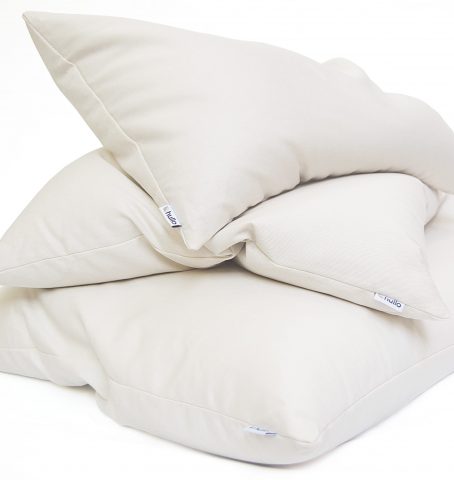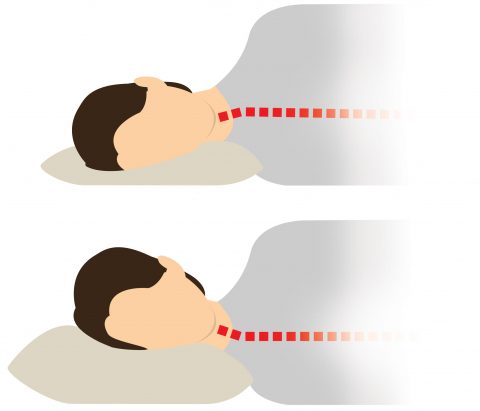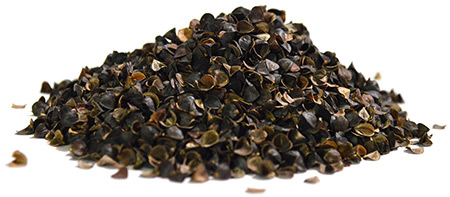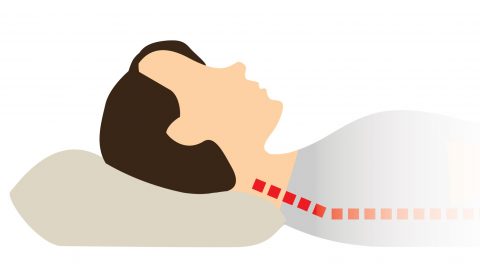
A pile of Hullo™ buckwheat pillows
It took me a long time to realize just how important a pillow can be to a good night’s sleep.
I grew up with traditional soft pillows and assumed that I was getting the best rest possible. I thought any pillow was sufficient and not terribly unique.
Then a friend introduced me to buckwheat pillows.
He enthusiastically told me about his recent purchase and proclaimed it the “the best pillow ever.” He convinced me to order a small 14×20″ buckwheat pillow. When it arrived, I was very skeptical. It was hefty: it weighed about 4 pounds. I unzipped the pillowcase and found it full of thousands of tiny three-sided brown shells. The buckwheat hull fill made it feel unlike any pillow I’d ever tried before.
I didn’t take to this interesting new pillow immediately. In fact, it took awhile for me to really appreciate it. I’m really glad I gave it a chance because I fell in love with it.
Buckwheat pillows helped me understand what a good pillow truly is.
After years of sleeping on my magical buckwheat pillow, exhaustively comparing other pillow types, and finally selling them, I’ve become a bit of a pillow pundit. I’ve distilled buckwheat pillows benefits down to three main points. Prepare to be educated / (bored to sleep?)!
The 3 Benefits of a Buckwheat Pillow

If your pillow doesn’t keep your head at the correct level, you may experience back and neck pain.
1. Superior Support
Your pillow’s most important job is to comfortably and consistently support your head and neck. A good pillow will cradle your body all night in what’s called “neutral alignment.” It will help to keep all the bits and pieces in your spine in in their ideal positions, preventing unnecessary pressure on your discs, muscles and nerves. Proper support=comfort.
Soft squishy traditional pillow types can collapse under the weight of your head, or are inevitably too thin/thick. They aren’t conducive to good rest!
Ideal support is accomplished with:
- proper elevation of your head. Your head isn’t positioned too high or too low, preventing uncomfortable bends and twists in your spine.
- even distribution of your head’s weight. Your head’s mass is uniformly spread across the pillow’s surface; there are no uncomfortable pressure points.
- consistent fill density. Your pillow’s fill will not collapse or flatten under the pressure of your body, keeping your head and neck consistently aligned all night.
A buckwheat pillow’s adjustable loft provides ideal support for everyone regardless of body type or sleep position.
It’s quite likely that any non-adjustable pillow you buy will be either too thick or thin for you. Fortunately most buckwheat pillows allow you to adjust the thickness, or loft, by adding or removing fill via a zippered opening (don’t get a buckwheat pillow without this feature). It doesn’t matter what size you are or what sleeping position you prefer, a buckwheat pillow can support your head at the correct elevation. You’ll be able to fine-tune the loft so that your head and neck are positioned just right.
A buckwheat pillow’s filling will conform perfectly to the shape of your head, evenly distributing your head’s weight.
Most soft pillows cannot not support your head as completely as a buckwheat pillow does. A buckwheat pillow’s unique hull filling will conform to the shape of your head and neck precisely. Its malleable character allows it to firmly and evenly distribute your head’s weight eliminating pain-causing pressure points.
The individual buckwheat hulls’ irregular shape causes friction between them that enables the pillow to hold its shape.
A buckwheat pillow won’t collapse in the middle of the night.
Unfortunately most traditional soft pillows slowly flatten out under the weight of your head while you sleep. This will result in an uncomfortable downward bend in your neck. Folding your pillow in half is popular solution. Unfortunately this often creates the opposite problem: an upward bend in your neck.
Continually re-fluffing or adjusting your in the middle of the night to get a bit more loft (thickness) out of your pillow, isn’t the best way to sleep!

A breathable pillow is a cool pillow.
2. Stays Cool
Down, foam and other pillow types retain body heat and can quickly become hot and uncomfortable. Have you ever woken up in the middle of the night and had to flip your pillow to the cool side? That doesn’t happen with buckwheat pillows. You’re on the cool side all night.
Buckwheat pillows’ cooling ability is due to the breathable nature of buckwheat hull fill. lt allows warm humid air absorbed from your body to quickly escape the pillow, preventing uncomfortable heat build-up.

Buckwheat hulls are an all-natural option that’s safe for both you and the environment.
3. Good For You, Your Family, and Mother Earth
Many popular pillow types contain polyurethane or polyester foam that can emit toxins and carcinogens that aren’t good for you or our environment. There’s no sense in risking your health or filling our landfills with potentially toxic waste!
The comfort of buckwheat pillows comes with no strings attached.
Buckwheat pillows are safe for your family and the environment. Buckwheat crops benefit little from chemical fertilizers, thus it is free of many of the contaminants that are present in other crop types. The hulls are also compostable, which helps to reduce unnecessary waste in our landfills and keeps our soil healthy and nutrient rich for future generations. Additionally, buckwheat pillows contain no animal products for those interested in a vegan lifestyle.
Consider trying Hullo™ buckwheat pillow.
If you’ve decided a buckwheat pillow is worth giving a shot, please consider our product, Hullo™. We think it’s the best buckwheat pillow available, but don’t take our word for it, check out these customer reviews.

The right pillow provides comfortable support, keeping your head, neck and spine in a neutral position all night long.
The position you sleep in has direct effects on your health. Sleeping position can affect your respiration, spinal alignment, and even wrinkling of the skin. There are proven ways to get a better nights sleep by using the right pillow, with the right amount of fill, and sleeping in the right positions.
Knowing how to sleep properly can improve your quality of life.
Your sleeping position and pillow work together to provide support for your head, neck and spine. Ideally, your spine is kept in what’s called a neutral position. A neutral sleeping position keeps all the bits and pieces in your back in an ideal posture, preventing unnecessary pressure on your discs, muscles and nerves. Keep your spine neutrally aligned and you’ll avoid discomfort (or worse).
Your preferred sleep position will help determine the best type of pillow suited for you.
Side Sleeping Position

Sleeping on your side with the wrong pillow can interfere with sleep and even lead to serious neck or back pain.
Sleeping on one’s side is the most common sleeping position. For most, it’s the instinctive and most comfortable way to sleep.
Side sleepers will prefer a high-loft (thicker) pillow.
This simply because there is more space to fill between your head and the mattress while on your side vs. other sleep positions. When you lie on your side, your pillow needs to be thick enough to keep your spine straight, but not so thick that it bends your neck out of alignment.
Side sleepers will be most comfortable on a firm or extra-firm pillow.
A common issue for side sleepers is that their pillow slowly collapses under the weight of their head during the night, becoming too thin. This loss of support will cause your head and neck to bend downwards, resulting in unnecessary strains that can lead to neck or back pain. Folding a pillow in half or using more than one pillow will not compensate for inadequate loft and support.
Read More: What Are the Best Pillows for Side Sleepers?
Read More: Learn How to Sleep on Your Side for Better Health
Back Sleeping Position

Most people are familiar with the discomfort associated with a pillow that is not the correct thickness.
Apparently 14% of us are back sleepers. Most sleep experts recommend back sleeping because it encourages better sleeping posture. Your head, neck and back are kept in a consistently neutral and comfortable position while on your back.
Back sleepers will prefer thinner low-loft pillows.
The best pillow for back sleepers will adequately fill the space between yourself and the mattress, elevating your head only as high as is needed to achieve a neutral position. A pillow that’s too thick will elevate your head too high. As a result, your neck is bent upwards, potentially straining muscles, nerves and discs.
Conversely, a pillow that’s too thin will result in an uncomfortable downward bend in your neck.
A supportive, malleable pillow will prevent lateral neck twists and strains.
When on your back, gravity will pull your head to your left or right shoulder as you sleep. The ideal back sleeper pillow keeps your head positioned relatively straight, or upright, facing the ceiling. This reduces the lateral twist in your neck.
Read More: How to Choose the Best Pillow for Back Sleepers
Read More: Learn How to Sleep on Your Back
Stomach Sleeping Position

This guy is going to feel it tomorrow!
Avoid sleeping on your stomach as it’s difficult to maintain a neutral sleeping position.
Sleeping on your stomach forces your head and spine into an unnatural upward bend. Staying in this position for hours on end is not good for your back or neck and can result in significant discomfort and restless sleep.
Can’t change your sleeping position? Stomach sleepers will prefer low-loft pillows.
Stomach sleepers need considerably less fill in their pillow than someone who sleeps on their side or back. If you sleep on your stomach with a pillow that’s too thick (most traditional pillows are), your spine will bent at an angle which is more likely to cause aches, pains, or numbness.
A breathable pillow type that doesn’t retain heat will help to keep stomach sleepers cool.
Being that your exhaled breath is directed downward toward your pillow, it’s helpful to use a pillow type that doesn’t retain heat. Most traditional pillow fill can get pretty toasty if you’re blowing hot air into it all night.
Read More: Choosing the Best Stomach Sleeper Pillow
Read More: Sleeping on Your Stomach: Make the Most of It!
Your sleeping position matters.
It may seem impossible to control the position you sleep in since you aren’t aware while sleeping. If you have bad sleep posture, it is feasible to make a change. Good habits can make a considerable difference in the amount and quality of sleep you get.
When going to sleep, or if you wake up in the night, make a conscious effort to follow these guidelines:
- Keep both your head and neck straight, in a neutral position, avoiding any twists and bends in your spine.
- Use malleable pillows that are capable of conforming to your neck and spine as you change positions throughout the night.
- According to the Mayo Clinic, “The most common sleeping position is on your side, with your legs and hips aligned and flexed. Because this position leaves your upper leg unsupported, the top knee and thigh tend to slide forward and rest on the mattress, rotating the lower spine. This slight rotation may contribute to back or hip pain. To prevent that problem, place a pillow between your knees and thighs…If you sleep on your back, place a pillow under your knees to help maintain the normal curve of your lower back. You might try a small, rolled towel under the small of your back for additional support. Support your neck with a pillow.”
How do I find the right pillow?
Squeezing products wrapped in plastic at the local store isn’t the way to find the best pillow. Ultimately, it’s preferable to test drive pillows in your own bed. Check the manufacturer’s return policy and make sure that you’re able to try it for at least a week. If it’s not right for you, toss it back in the box and return it.
You spend a third of your life with your head resting on a pillow, so a little extra shopping and experimentation is absolutely worth it.
I have a recommendation that works well for all sleep positions!
In case you haven’t guessed, we are huge fans of buckwheat pillows. Such huge fans that we started manufacturing and selling them ourselves. Their unique hull filling makes them supremely comfortable for all sleeping positions.
Buckwheat pillows are extremely effective at providing even and consistent support for you head and neck.
The thousands of tiny hulls will perfectly conform to the space between your head and the mattress eliminating potentially pain-causing pressure points in your neck and back. Buckwheat pillows offer firm, consistent support that will keep your head and neck comfortably positioned all night long.
Buckwheat pillows are adjustable.
High-quality buckwheat pillows always have a zipper. A zipper enables adjustment of the amount of filling in the pillow. As a result, you’re able to dial-in the thickness of your pillow so that it’s just right for you. Simply add or remove the buckwheat hull filling.
Buckwheat pillows are breathable.
The irregular and hollow shape of buckwheat hulls creates airspace within your pillow. Its breathable nature results in a cool, dry pillow, that gives you the “cool side of the pillow” effect all night long.
Buckwheat pillows are made from natural renewable materials.
Many popular pillow types contain polyurethane or polyester foam that can emit toxins and carcinogens that aren’t good for you or our environment. There’s no sense in risking your health or filling our landfills with potentially toxic waste!
Moreover, buckwheat crops benefit little from chemical fertilizers. It is free of many of the contaminants that are present in other crop types and is safe for your family and the environment. The hulls are compostable, which helps to reduce unnecessary waste in our landfills. It also keeps our soil healthy and nutrient rich for future generations. Finally, buckwheat pillows contain no animal products for those interested in a vegan lifestyle.
Try a buckwheat pillow.
Sleep on a Hullo for 60 nights. If you don’t care for it, just ship it back to us and we’ll refund the purchase price. Don’t take my word for it, read our customers’ reviews.
 Are you the owner of a new Hullo™ buckwheat pillow? Congratulations!
Are you the owner of a new Hullo™ buckwheat pillow? Congratulations!
Here are some important things you should know as you get started:
1. Get Comfortable
Push the sides of Hullo together, creating a tall mound of buckwheat hulls inside. Next, sink your head into the pillow—the fill will slide away, conforming perfectly to the shape of your head, shoulders and neck. If Hullo feels too firm or thick, you may find it preferable to remove some of the buckwheat hull filling. Conversely, if you feel you need a thicker pillow, contact us.
2. Give It Some Time
We’re confident you’ll love Hullo, but because a buckwheat pillow is so different from traditional pillows, it can take some getting used to. Our advice: be patient, experiment with the fill and take your time with it. If you are not satisfied with your Hullo, contact us within 60 days of your purchase for return instructions and a full refund.
3. Take Care
Like any bed pillow, we recommend that you insert Hullo into a traditional pillow case (zipper down) to protect it from oils, dust and dirt. When cleaning is required, first remove the buckwheat hulls from Hullo’s zippered opening. Dump the hulls into a paper grocery bag, wash the fabric shell in cold water, then air-dry. Finally, replace the buckwheat hulls.
If you have any questions about Hullo, or buckwheat hull pillows in general, feel free to contact us. We’re also available to answer your questions on Facebook and Twitter.
